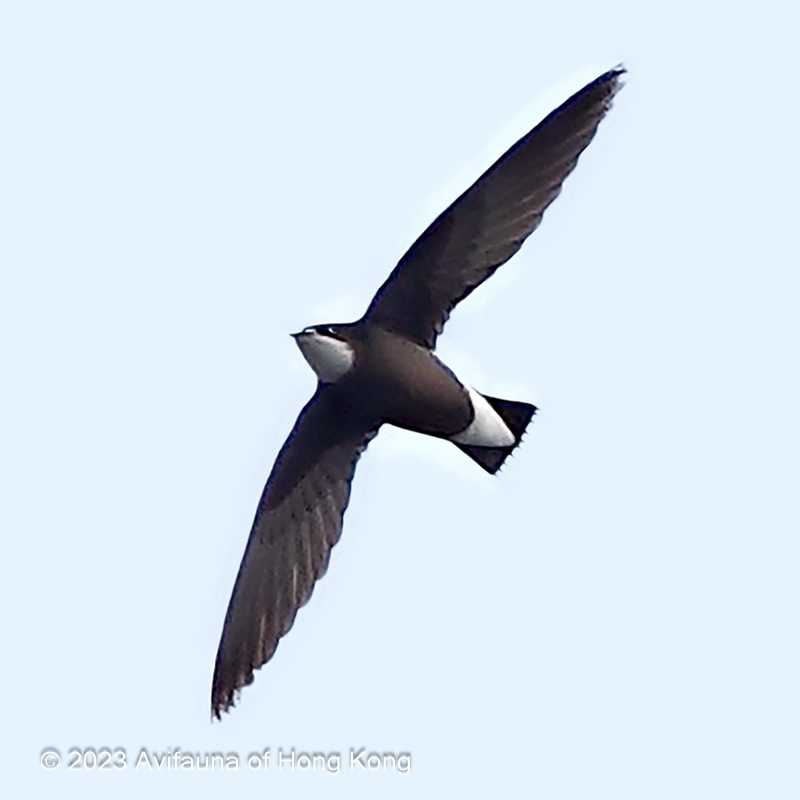WHITE-THROATED NEEDLETAIL Hirundapus caudacutus 白喉針尾雨燕
Category I. Scarce spring passage migrant in variable numbers that has substantially declined since the 1990s.
IDENTIFICATION

Apr. 2021, Morten Lisse

Apr. 2012, Michelle and Peter Wong
19-21 cm. Sexes alike. A large, long-winged, blue-glossed dark-brown swift with a pale grey saddle, a contrasting broad white throat, white lores and white forehead-band, and a white horseshoe shape on the rear flanks and undertail coverts. The tail is square-cut and has short protruding spines at the tip, but these are usually only visible at close range. With decent views, the head and throat pattern distinguish White-throated Needletail from Silver-backed Needletail.
VOCALISATIONS
There are no reports of birds vocalising in HK. However, Chantler and Driessens (1995) describe it as a ‘rapid insect-like chattering’, which may be similar to that of Silver-backed Needletail.
DISTRIBUTION & HABITAT PREFERENCE
This species forages over fish ponds, marshes, wooded hills and valleys, and escarpments. It has occurred at widespread sites with several records from the Deep Bay area, Tai Lam CP and Po Toi in recent years.
OCCURRENCE
Scarce spring passage migrant, with only two autumn records. It was of near-annual occurrence in small numbers up to the end of the 1990s, but this is no longer the case as it occurred in just 11 years during 1999-2020. There have, however, been a small number of unusually high recent counts (see below).
Extreme dates of spring migrants are 25 March and 15 May, although most records are between mid-April and the first week of May (Figure 1). Many sightings are of singles or birds in small parties, but larger flocks have occurred, usually in association with inclement weather. The passage of Typhoon Leo in early May 1999 resulted in counts of 23 at Cape D’Aguilar on 2 May and 20 at Mount Austin on 4 May. These high counts were exceeded by an unprecedented flock of 120 at Shek Kong catchwater on 20 April 2016 during the passage of a cold front. In addition, 2020 saw smaller but still significant counts of 42 at Tsim Bei Tsui on 24 April during heavy rain, and 25 at Chek Lap Kok on the following day.
The two autumn records comprise one near Fairview Park on 19 September and at Long Valley on 24 September 1995 (presumed the same bird), and four at KFBG on 27 October 1997.
The first record of this species in HK was of ten at Beas River on 21 April 1977 (Cooper and Chalmers 1979). Since this species was recorded in May in Guangxi (Yen 1933-34) and ‘practically over the greater part of China’ including in Fujian (La Touche 1931-34), it seems likely it was overlooked before 1977.
BEHAVIOUR, FORAGING & DIET
Feeds on flying insects over fish ponds, forested hills, and shrubby escarpments. It has a graceful and powerful flight, and the wings make an impressive whooshing sound when birds pass low overhead.
RANGE & SYSTEMATICS
H. c. caudacutus breeds from central Siberia east to Sakhalin and the Kuril Islands, and south to north and east Mongolia, northeast China, Korea and Japan; it is a migrant through much of the eastern half of China, including HK, and winters in south New Guinea and eastern Australia. H. c. nudipes breeds in the Himalayan foothills from north Pakistan east through northern Myanmar to southwest China (eastern Tibet, Sichuan and Yunnan); its wintering area is not well-documented but possibly includes the Malay Peninsula and Java (Chantler and Kirwan 2020).
CONSERVATION STATUS
IUCN: Least Concern. Population trend stable.
Figure 1.

Chantler, P. and G. M. Kirwan (2020). White-throated Needletail (Hirundapus caudacutus), version 1.0. In Birds of the World (J. del Hoyo, A. Elliott, J. Sargatal, D. A. Christie, and E. de Juana, Editors). Cornell Lab of Ornithology, Ithaca, NY, USA. https://doi.org/10.2173/bow.whtnee.01
Cooper, G. C. H. and M. L. Chalmers (1979). Report on the birds 1977. Hong Kong Bird Report 1977: 4-7.
La Touche, J. D. D. (1931-34) Handbook of the birds of Eastern China Vol. 2. Taylor and Francis, London.
Yen, K. Y. (1933-34). Les oiseaux du Kwangsi (Chine). L’Oiseau et la Revue Francaise d’Ornithologie (NS) 3: 204-243, 615-638, 755-788; 4: 24-51, 297-317, 489-507.

